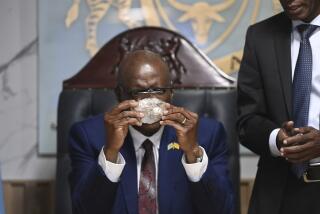Flawless Gem Expected to Bring $20 Million at Auction : Mysterious Past Attends 407-Carat Diamond
- Share via
NEW YORK — It came from the earth into unknown hands perhaps five to 10 years ago, crusted, dirty and, to the untrained eye, with no hint of the golden heart inside. It was likely formed in the depths of Africa, no one knows when, by prehistoric fire and pressure.
Now it has been stripped of its weathered exterior and the imperfections that cloaked its beauty, and on Oct. 19, at Christie’s, the highest bidder will get a golden gem of 407.48 carats, the largest flawless diamond in the world, the second-largest diamond in human hands and worth whatever it will bring, probably more than $20 million.
The stone’s recent past is a mystery. Someone in Ghana or South Africa or somewhere found it, brought it out and sold it to someone else. It passed from knowing hand to knowing hand.
“It was mined by someone, someone who found the piece of rock, only one person,” said Francois Curiel, the 39-year-old Frenchman who heads Christie’s jewelry department in New York. Then it left South Africa, either by a private route or through DeBeers, the huge diamond trust, or through another person.
Gem’s Past Kept Secret
“There must have been an intermediary,” Curiel said. The present owners will not tell Christie’s how they got the stone or how much they paid for it, and Curiel would not say for how much it is insured.
“Why $20 million?” Curiel said. “I don’t know. The most expensive diamond ever sold was about $10 million, but it was an 85-carat stone. This is not a white stone (as the previous record-holder was), so you can’t really compare it.”
The world’s largest diamond, the 530.20 carat Cullinan I, “The Great Star of South Africa,” is set in Britain’s Imperial Sceptre as part of the Crown Jewels, and therefore is out of circulation. It is on display in the Tower of London.
“We don’t believe the Cullinan is flawless,” Curiel said. It was cut in 1911, and the field of gemology was more art than science. Now things are more precise, more scientific. “Nobody knows whether it is flawless or not.”
Christie’s counts on the fingers of both hands the number of potential buyers, those with the money and reason to sport such a stone.
It will be, Curiel said, “someone who wants the prestige of buying the largest flawless stone in the world . . . either for a corporate seal or a scepter or for a tiara. I do not believe it will be purchased by someone who will give it to his wife.” It will be a symbol of status.
Displayed Around World
Christie’s has taken the diamond on the road and shown it to prospective buyers, in Hong Kong, Tokyo, Los Angeles, London.
“I don’t travel with it,” Curiel said. “I would be an obvious target.”
So this queen of gems is carried by an armored service or in the company of three or four armed guards. It depends on where it is going. “Every country poses a different problem,” Curiel said.
Not so in the secure heart of Christie’s. Curiel, also an executive vice president and director of the firm, casually interrupts a phone conversation to call out: “Diane, the diamond, please!”
Diane brings it in a small black box that doesn’t fit together properly. Inside the gem is nestled in crumpled tissue paper.
It took three years, beginning in 1985, to cut the diamond from the 890-carat stone in which it was mined. Diamond cutters do not work by the hour, but by the carat.
Artisan Jacques Swaab began the job. He worked for six months to determine the most economical shape, a shield or triolet, a complicated, asymmetrical triangular design more than 2 inches long, about 1 inches wide and a fraction over 1 inch deep. Curiel, who will conduct the auction, pointed to one quarter-inch facet and said: “It probably took a month to make that one cut.”
Exhibited in Capital
The cutting was finished this year by another artisan, Hy Kessler, and the diamond drew crowds to an exhibit at the Smithsonian Institution in Washington.
The finished gem fits easily in the palm of a hand and weighs about as much as a cigarette lighter.
The current owners, New York jewelry dealers Marvin Samuels and Louis Glick, in partnership with the Dallas retail chain Zale Corp., would not explain their reluctance to discuss the diamond’s origins.
April of this year was a big month for diamonds. On April 19, Sotheby’s auctioned an 85.91-carat white diamond for $9,310,000. A day later, Christie’s sold a 52.59-carat stone for $7,480,000, a record per-carat price for a white diamond. At that rate, the new diamond would bring more than $57 million, but Curiel says the two gems cannot be compared.
In April, 1987, Curiel said, he sold a rare red diamond weighing less than one carat for $880,000--an all-time record price per carat.


